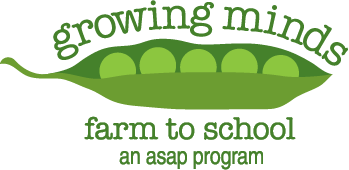| Classroom Activity | Accompanying Books | Description | Suggested Month |
| Planting in the Garden | The Giant Carrot |
Students choose what to grow, how to grow it, and when to plant a fall garden. |
August |
| Seed Tapes | The Tiny Seed |
Students will learn proper seed spacing for planting in the garden. |
August |
| Watering the Garden | Water, Weed, and Wait |
Students will learn that plants need water just like people and animals need water. They will explore dry and wet soil and be able to describe the difference between them. They will be introduced to a rain gauge and its purpose. |
August |
| Searching the Garden Safely | Jack’s Garden |
As a class, students will create “garden tips” that will teach and reinforce appropriate garden behavior. Students will use their senses to explore and investigate the world around them. |
August |
| Edible vs. Non-Edible | Gregory the Terrible Eater |
Students will learn the difference between edible and non-edible and understand how these concepts connect to a garden and the objects and properties of a garden. Through a visit to the garden and by utilizing charts and discussion questions, students will expand their understanding of edible, non-edible, and the garden environment. |
September |
| Garden Alphabet | A Farmer’s Alphabet, A Gardener’s Alphabet |
Students will make observations and build an understanding of the properties of common objects in the garden. They will share information about what is in the garden by describing the objects through illustration and descriptive writing. |
September |
| Butterfly Life Cycle | Where Butterflies Grow |
Teach students about insect life cycles through a close look at butterflies. |
October |
| Changing Leaves and Changing Seasons | Leaves Fall Down: Learning about Autumn Leaves |
Teach students about changing seasons and the season of autumn. Students create a leaf spinner and record daily temperatures. |
October |
| Harvesting in the Garden | Pick, Pull, Snap!: Where Once a Flower Bloomed |
Students will review characteristics of mature produce and learn how to harvest different types of fruits vegetables. As a class, students will make harvesting calendars and apply their harvesting skills in the garden. |
November |
| Root Exploration | What Do Roots Do? |
Introduce students to roots and the ways they function. Talk with students about the 5 “Ws” (who, what, when, where, and why) and teach them as a guide for creating a poem. |
November |
| Stem Exploration | Stems |
Teach students about the parts of plants and their functions and use the garden to teach a hands-on plant based activity. |
November |
| Insect Exploration | Cucumber Soup |
Introduce students to the insects and other creatures they will find in the garden and their characteristics. |
December |
| Making Garden Signs | Our School Garden |
Students will learn to identify plants in the garden and work together to make garden signs. |
January |
| Soil Exploration | Dirt |
Through garden exploration, students will learn about the properties of soil and why soil is important to plants. They will closely observe soil and practice tallying and reporting results of soil experiments. |
January |
| Soil Amendments | Garbage Helps Our Garden Grow |
Students learn about the benefits of soil amendments and spend time recording their garden observations. |
February |
| Garden Planning | This Year’s Garden |
Students learn what people need to create a successful a garden and what plants need to thrive. Through a hands-on activity, students learn about mapping and construct a “bird’s-eye-view” picture of a garden bed. Through a reflection process, students work together to make group decisions in planning a classroom garden. |
February |
| Literacy Beds | any piece of children’s literature with a garden theme |
The class will plan, plant, and grow a garden based on a piece of children’s literature. |
February |
| Love Letters to Nature |
Students will consider things they might be afraid of in the garden, then write a letter to that plant or animal. This lesson could be used for a Valentine’s Day activity. |
February | |
| Seasons on a Farm | The Year at Maple Hill Farm |
Students will learn about seasonal weather patterns and their effects on local farms and gardens and use qualitative and quantitative measurements to describe weather. |
March |
| Soil Temperature | And then it’s Spring |
Students will use thermometers to measure soil temperature and use the information to determine if the soil is warm enough to support plant growth. |
March |
| Poetry in the Garden | In Our Backyard Garden, Scarecrow |
Students will strengthen their creative writing skills by writing poems that connect with the garden. |
April |
| Seed Starting | From Seed to Plant |
Students will observe germination of different types of seeds and learn how to transplant seedlings into soil. |
April |
| Worm Exploration | Yucky Worms, An Earthworm’s Life |
Teach students about life cycles by learning about worms and the ways they benefit the garden and farms. Through reading literature and completing hands-on activities, the class will conduct a worm investigation and observe that the organisms (and other animals) need food, air and space to grow. |
May |
| Honey Bees | Brilliant Bees |
Students learn about communication by exploring honey bees and comparing them to other insects and animals. |
May |
